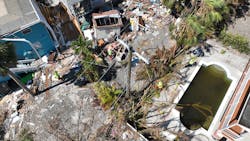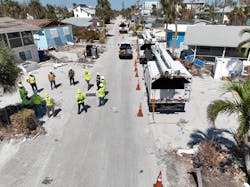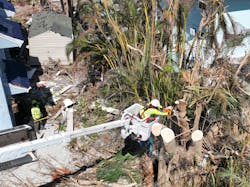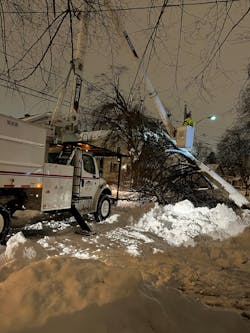Severe storms of all types — from wildfires to hurricanes and derechos to Nor’easters — are seemingly becoming more frequent, more intense and causing more damage to utility power systems than ever before. Despite the significant work being done by utilities and their contractors to harden systems and reduce the impact of weather-related outages, one destructive storm after another appears to have become a nearly year-round phenomenon. Storm is the new norm. With every storm, the first responders are called upon to work together to clear roads, remove trees, repair infrastructure and restore power for sometimes millions of customers. Crews face perilous conditions as they travel to job sites to perform their heroic work. Every move is in a dynamic, high-risk environment, so new tools for creating safety while performing restoration work are critical.
According to Deloitte’s 2022 Power and Utilities Industry Outlook, more than 3,100 extreme weather events occurred globally during the 2010s and more than 3,500 events happened between 2000 and 2009 — compared to just 711 in the 1970s. Deloitte’s 2022 Power and Utilities Industry Outlook reports that these unprecedented and unpredictable extreme weather events can badly disrupt the utility supply chain, challenging the grid’s reliability and resiliency and affecting utility business operations across the globe.
The problem seems to be getting worse. A U.S. interagency report projected that due to climate change, future extreme events causing power outages will be more frequent and last longer. Responding to the Deloitte survey, the majority of power and utility industry respondents have already noticed an impact. Fifty-one percent said extreme weather has affected the reliability of electricity delivery in their territory more than usual in the past year. More recent data backs up the claim. Florida Power & Light Company (FPL), America’s largest electric utility serving more than 12 million people, experienced damage impacting more than 2.1 million customers from Hurricane Ian in October 2022. A month later, Tropical Storm Nicole hit the east coast of Florida, affecting more than 480,000 customers. The economic impact to FPL’s system from just these two storms exceeded $1 billion.
Ratcheting Up Safety
When storms hit and the power goes out, oftentimes, line crews and vegetation management crews are the very first responders to move into an impacted area. Tree crews remove branches, fallen trees and other debris from roads, power lines and structures so police, fire and medical responders can move in, and utility workers can begin to restore essential power to homes and businesses.
“It’s often a chaotic situation filled with a great deal of uncertainty and hidden hazards,” says Leslie Kass, CEO of Lewis Tree Service. “What was once a pristine tree-lined street with solid utility infrastructure can become a scene of twisted branches, downed wires, broken poles and flooded roads in no time. While safety is always a top priority at Lewis, in these situations, the safety methods utilized by our restoration crews are of utmost importance.”
Three Phases of Restoration
Like many companies, Lewis leaders have a list of key performance indicators (KPIs) guiding their actions and tracked to measure success. When called upon to support their utility partners in response to an impending storm, the Lewis team quickly builds an ad hoc organization led by an operations vice president who uses a unique set of “Storm KPIs” for the duration of the event. The action often starts days before a predicted weather event is due to strike and doesn’t end “until the last crew safely returns home,” Kass says. Central to the Lewis KPIs are safety objectives including special attention to three distinct phases of action by every crew — mobilization, working and demobilization.
Heightened safety actions in route to the staging areas and going home are critical, especially when crews are relocating to an impact zone different from their normal work location. Having and using tools and techniques to work safely during storm response can create safety issues in a situation where typical methods and procedures have their limits. Dennis Brown, president and COO of Lewis, has seen his share of storm scenes in his more than 30 years in the industry.
“Just because the power may be out in a neighborhood or business doesn’t mean lines on the ground aren’t energized,” Brown says. “And trees laying across lines and poles can shift with the wind or flooding, so approaching the work from the perspective of ‘safety first, safety always’ is imperative.”
Sometimes, the downed lines aren’t even accessible via roadways due to flooding, so crews need to wade into these areas hand-carrying their tools.
“In places like Florida and Louisiana, the risks in these situations can even include displaced alligators, snakes and sharks,” Brown says. “In addition to the tools needed to perform their work, special safety methods and techniques help to de-risk these difficult situations.”
Human Performance in Action
Beth Lay, director of resilience and reliability, has been equipping crews with special safety tools since she came to Lewis in 2018. Following a fatality that occurred the week before she started, Lay began laying the foundation for a culture change. This shifted the focus from safety audits, incident investigations and blame-and-punish responses to accidents. This would allow leaders to learn from work done right and respond to failures with curiosity. They could also pose questions designed to drive learning rather than inhibit it.
Nowhere are these tools more important than in the ambiguity and stress incumbent in weather disasters. Lewis crews employed these human performance tools in storm response efforts throughout 2022 — both formally and informally — resulting in more than 500,000 hrs of work without incident.
Learning for Storms and Blue-Sky Days
It’s not the known risks that lead to injuries and fatalities, but rather the situations with the greatest uncertainty, according to Todd Conklin, author, safety speaker and human and organizational performance consultant. The aftermath of severe weather creates circumstances of almost infinite uncertainty for the utility and tree workers called upon to restore power, and with it, calm and order.
To help utility customers ride out the next storm with less damage and safer restoration, it’s imperative to listen, learn and stay curious, Lay says. For example, they must discover what crews are concerned about, what challenges they are facing and where they need help.
“This is the way to make discoveries, find opportunities and improve performance,” she says. “That’s how to create a human-centered safety and human performance culture.”
Steven Powell ([email protected]) is the director of marketing and business development for Lewis Services.
Spotlight on Safety Tools for Storm Response
In the wake of severe weather, line crews and vegetation management teams must focus on safety in the field. Here are just a few ways that Lewis has kept a focus on safety during storm work.
After-Action Reviews. Despite 16-hr workdays in 90-deg heat, Lewis crews and their utility partners in line and vegetation management teams conducted AARs at the end of each workday to share close calls, learnings and tips to prepare for the next day. Within Lewis, the AARs were submitted to the safety team each night to be reviewed and shared across all corporate and operations teams on daily storm calls. These AARs are also stored in a repository for reference and sharing on future storms. A common theme in AARs submitted by several crews was managing the pressure building due to rising tensions in the general public and adverse encounters with homeowners stressed by the storm.
Peer Check. A Lewis crew member working in Florida area approached contractors providing fuel services to ask them how they were doing and discovered they had been working all day without eating. The Lewis worker went to the staging area and brought back lunch and water for the fuel crews.
Team Building. Recognizing the potential emotional impact of Lewis workers missing Christmas Eve and Christmas Day with their families while responding to Winter Storm Elliott in Buffalo, New York, a Lewis general foreman opened his home to out-of-town crew to spend Christmas eve together.
Situational Awareness, Forecasting and Reframing. After a 20-hr day that included two-hour trips on both ends of moving from a staging area to the assigned work zone, Lewis team leaders voiced a concern about starting the following day at the 6 a.m. time requested by their assigned utility forester. Escalating the request to Lewis management and eventually to a decision-maker in the utility, the crews were given permission to prioritize their rest, allowing them to start fresh at noon the following day.
Another example of situational awareness is when utility and Lewis crews discuss a gameplan and stop many times in the process of installing grounds, testing lines and performing tree removal and line restoration work before giving the okay to work.
About the Author
Steven Powell
Steven Powell ([email protected]) is the director of marketing and business development for Lewis Services.




